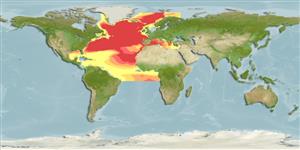Common names from other countries
Classification / Names / Names
Common names | Synonyms | Catalog of Fishes (gen., sp.) | ITIS | CoL | WoRMS
Environment: milieu / climate zone / depth range / distribution range
Ecology
Bathypelagic; depth range 100 - 5000 m (Ref. 79146). Subtropical; 75°N - 7°S, 98°W - 36°E
Atlantic, Eastern Gulf of Mexico and the Mediterranean: Norway to Faeroe, to Cape Verde and Angola and Mediterranean, Nova Scotia to the Gulf of Mexico and the Antilles.
Length at first maturity / Size / Weight / Age
Maturity: Lm ? range ? - ? cm
Minimum depth from Ref. 97531. Exhibits diel vertical migration (Ref. 106104). Carnivores on macrozooplankton-micronekton (Ref. 106105).
Life cycle and mating behavior
Maturity | Reproduction | Spawning | Eggs | Fecundity | Larvae
Members of the order Decapoda are mostly gonochoric. Mating behavior: Precopulatory courtship ritual is common (through olfactory and tactile cues); usually indirect sperm transfer.
Pérez Farfante, I. and B. Kensley. 1997. (Ref. 75620)
IUCN Red List Status (Ref. 130435)
CITES status (Ref. 108899)
Not Evaluated
Not Evaluated
Human uses
Fisheries: commercial
| FishSource |
Tools
Internet sources
Estimates based on models
Preferred temperature
(Ref.
115969): 3.3 - 13.6, mean 4.4 (based on 943 cells).
Resilience
High, minimum population doubling time less than 15 months (K=0.64).
